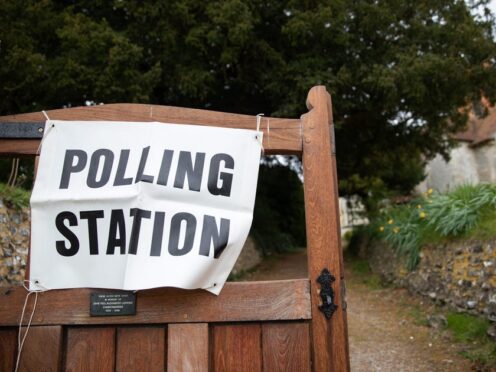What does a polling station worker do and who are they?
Those working in polling stations on election day are usually there from around 6am to 11pm to help guide voters through the process. They are trained in the weeks leading up to the election. They also get paid for their work.
The workers issue ballot papers, check the register of electors and mark people off as they vote, and set up and close the polling station at the beginning and end of the day.
They are required to be 18 years old or over, have a right to work in the UK, speak English to “a good standard” and must not have worked for a candidate in the current election.
[pa_oembed = ccbd56ad9eae2bc1c294249dad55b0f9]What is a polling station, where are they located, and what goes on in there?
Polling stations are located up and down the country, often in schools, village halls or other public buildings.
Each voter is assigned a polling station that is close to their registered address and they have to go to that place to vote. At most 2,250 voters are allocated to each polling station.
They are open between 7am and 10pm on polling day. Those in the queue outside the polling station at 10pm will still be allowed to vote.
It is not permitted to take photos inside the polling station.
Candidates are allowed to enter polling stations, but must not canvass voters. They can appoint polling agents who can enter the stations and observe the voting, although only one polling agent per candidate can enter the polling station at a time.
If for some reason, such as a fire or bomb scare, a polling station has to be evacuated, the polling team will set up “a temporary polling station at a safe distance”. In extreme cases the poll can be adjourned until the following day.
There are about 40,000 polling stations in the UK on polling day, with more than 150,000 polling staff working at them.
According to Democracy Club, which supplies data to the Electoral Commission, polling stations are mainly located in various types of hall (11,000), with schools (3,500-3,800), community centres (2,700) and church halls (2,000) being other common spaces.
Other locations included cricket clubs/pavilions (120), football/rugby stadia or clubs (185), mosques (10), hospitals (10), synagogues (15) and masonic halls (35).
There was also a polling station in a seafood restaurant, in skittle alleys, a laundrette and two carpet shops.
The organisation said that the data “should be treated with caution”.
[pa_oembed = 8213b020e177cd6a5a19cfe1247d075a]What happens after polling closes?
After the last person has voted the presiding officer seals the ballot box. Candidates, election agents or polling agents may add their own seal to the box as well.
After paperwork has been completed the ballot boxes are then transported to the count centre to be counted.
How are votes counted?
The UK does not use voting machines at general elections. Therefore all votes are counted manually.
Counting can take place overnight, the following day or in some situations the week following polling day, depending on several factors including the type of election.
In a UK parliamentary election “reasonable steps” must be taken to ensure votes start being counted within four hours of the polls closing.
After a ballot box is opened, the number of ballot papers in the box are counted to make sure they match the paperwork that was completed at the polling station.
The ballot papers are then mixed with postal vote ballot papers, which have been verified earlier in the day, and with ballots from other boxes in order to preserve the secrecy of the vote. Then the count begins.
The way votes are counted depends on what type of election has been held.
[pa_oembed = 9e1841a34c75989d0d5b63d7612f4490]What are spoilt ballots?
Ballots that have been incorrectly marked – such as having marks next to two candidates in an election where voters are only allowed to mark one candidate – are considered spoilt.
There are also doubtful ballots, which can include those where a cross stretches across two candidates. The returning officer decides whether or not to reject these ballots.
If the intention of the voter is “clearly apparent” then the vote can still be accepted.
[pa_oembed = 05c407c635baa2349faaa7c429e84b6c]What happens after the votes are counted?
After votes have been counted the returning officer announces the result of the election and declares who won it.
If two candidates get the same number of votes, then a lot is drawn to decide the winner. There are different ways of drawing a lot. It is up to the returning officer to decide which method to use.
[pa_oembed = a8f65c21101ecfe8a2ea9d2b2677f60f]Who are the people counting the ballots?
Counting staff should ideally have previous experience of counting ballots, a “good head for figures”, be well organised and work under pressure. They sort and count the ballot papers and are paid for their work.
Links
Electoral Commission – Working at a polling station (archived)
Hammersmith and Fulham – Electoral services recruitment (archived)
Electoral Commission – Polling day stories (archived)
Gov.uk – How to vote, Voting in person (archived)
Electoral Commission – Guidance for (Acting) Returning Officers administering a UK Parliamentary election in Great Britain (archived)
Vale of White Horse District Council – What happens at a polling station on election day? (archived)
Electoral Commission – Handbook for polling station staff (archived)
Electoral Commission – Work at elections (archived)
Democracy Club – What do 35,500 polling stations look like? (archived)
PA Fact Check – Votes are not cast electronically in UK general elections (archived)
Electoral Commission – How votes are counted (archived)
Electoral Commission – Easy guide to the count (archived)
Electoral Commission – Introduction to our candidates guidance (archived)
